How to Read a Input From Search Bar in Jinja
Flask comes packaged with the powerful Jinja templating language.
For those who accept non been exposed to a templating language before, such languages essentially contain variables too every bit some programming logic, which when evaluated (or rendered into HTML) are replaced with actual values.
The variables and/or logic are placed between tags or delimiters. For case, Jinja templates use {% ... %} for expressions or logic (like for loops), while {{ ... }} is used for outputting the results of an expression or a variable to the end user. The latter tag, when rendered, is replaced with a value or values, and is seen by the end user.
Quick Examples
Make sure you lot have Jinja installed earlier running these examples (pip install jinja2):
>>>
>>> from jinja2 import Template >>> t = Template ( "Hello {{ something }}!" ) >>> t . return ( something = "World" ) u'Hello World!' >>> t = Template ( "My favorite numbers: { % f or northward in range(ane,10) %}{{n}} " "{ % e ndfor %}" ) >>> t . render () u'My favorite numbers: 1 2 three 4 five 6 7 8 nine ' Notice how the actual output rendered to the user falls within the tags.
Flask Examples
The code can be found here.
Create the following project structure:
├── requirements.txt ├── run.py └── templates Activate a virtualenv, then install flask:
Add the post-obit code to run.py:
from flask import Flask , render_template app = Flask ( __name__ ) @app . route ( "/" ) def template_test (): return render_template ( 'template.html' , my_string = "Wheeeee!" , my_list = [ 0 , 1 , two , 3 , 4 , 5 ]) if __name__ == '__main__' : app . run ( debug = True ) Here, we are establishing the route /, which renders the template template.html via the part render_template(). This function must have a template name. Optionally, you can pass in keyword arguments to the template, like in the example with my_string and my_list.
Add the template:
<!DOCTYPE html> < html > < caput > < title >Flask Template Case</ title > < meta name = "viewport" content = "width=device-width, initial-calibration=ane.0" > < link href = "http://netdna.bootstrapcdn.com/bootstrap/3.0.0/css/bootstrap.min.css" rel = "stylesheet" media = "screen" > < style type = "text/css" > . container { max-width : 500 px ; padding-top : 100 px ; } </ style > </ head > < trunk > < div grade = "container" > < p >My string: {{my_string}}</ p > < p >Value from the list: {{my_list[3]}}</ p > < p >Loop through the listing:</ p > < ul > {% for n in my_list %} < li >{{n}}</ li > {% endfor %} </ ul > </ div > < script src = "http://code.jquery.com/jquery-ane.ten.ii.min.js" ></ script > < script src = "http://netdna.bootstrapcdn.com/bootstrap/3.0.0/js/bootstrap.min.js" ></ script > </ body > </ html > Save this as template.html in the templates directory. Notice the template tags. Can you judge the output earlier you run the app?
Run the following:
Yous should meet the following:
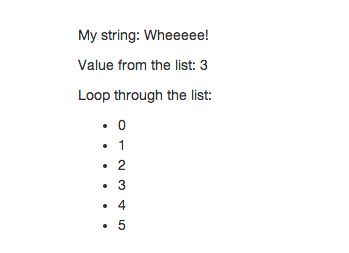
Template Inheritance
Templates usually take advantage of inheritance, which includes a single base template that defines the basic construction of all subsequent child templates. Yous utilize the tags {% extends %} and {% block %} to implement inheritance.
The use case for this is simple: every bit your application grows, and you continue adding new templates, you lot will need to keep common code (like an HTML navigation bar, Javascript libraries, CSS stylesheets, and and so forth) in sync, which can be a lot of work. Using inheritance, nosotros tin motion those mutual pieces to a parent/base template so that we tin create or edit such code once, and all child templates will inherent that code.
Let's add inheritance to our example.
Create the base (or parent) template:
<!DOCTYPE html> < html > < head > < title >Flask Template Instance</ title > < meta proper noun = "viewport" content = "width=device-width, initial-scale=i.0" > < link href = "http://netdna.bootstrapcdn.com/bootstrap/3.0.0/css/bootstrap.min.css" rel = "stylesheet" media = "screen" > < style type = "text/css" > . container { max-width : 500 px ; padding-height : 100 px ; } h2 { color : cherry ;} </ style > </ head > < body > < div class = "container" > < h2 >This is part of my base template</ h2 > < br > {% cake content %}{% endblock %} < br > < h2 >This is part of my base template</ h2 > </ div > < script src = "http://code.jquery.com/jquery-ane.10.2.min.js" ></ script > < script src = "http://netdna.bootstrapcdn.com/bootstrap/3.0.0/js/bootstrap.min.js" ></ script > </ torso > </ html > Save this every bit layout.html.
Did you lot notice the {% block %} tags? This defines a block (or area) that kid templates can fill in. Further, this just informs the templating engine that a child template may override the block of the template.
Let's do that.
Update template.html:
{% extends "layout.html" %} {% block content %} < h3 > This is the start of my kid template</ h3 > < br > < p >My string: {{my_string}}</ p > < p >Value from the listing: {{my_list[iii]}}</ p > < p >Loop through the listing:</ p > < ul > {% for n in my_list %} < li >{{n}}</ li > {% endfor %} </ ul > < h3 > This is the stop of my child template</ h3 > {% endblock %} Then, the {% extends %} informs the templating engine that this template "extends" another template, layout.html. This establishes the link between the templates.
Run information technology. You should see this:

One mutual use case is to add a navigation bar.
Add together the following code to the base template, just after the opening <body> tag:
< nav class = "navbar navbar-changed" role = "navigation" > < div grade = "container-fluid" > < div class = "navbar-header" > < push type = "button" class = "navbar-toggle" information-toggle = "plummet" data-target = "#bs-instance-navbar-plummet-1" > < bridge class = "sr-only" >Toggle navigation</ span > < span class = "icon-bar" ></ span > < span course = "icon-bar" ></ span > < span class = "icon-bar" ></ span > </ push > < a form = "navbar-make" href = "/" >Jinja!</ a > </ div > < div class = "collapse navbar-plummet" id = "bs-example-navbar-collapse-1" > < ul class = "nav navbar-nav" > < li class = "active" >< a href = "#" >Link</ a ></ li > < li >< a href = "#" >Link</ a ></ li > </ ul > < form class = "navbar-form navbar-left" office = "search" > < div form = "form-group" > < input type = "text" class = "class-control" placeholder = "Search" > </ div > < button type = "submit" class = "btn btn-default" >Submit</ button > </ form > < ul class = "nav navbar-nav navbar-right" > < li >< a href = "#" >Link</ a ></ li > < li class = "dropdown" > < a href = "#" class = "dropdown-toggle" data-toggle = "dropdown" >Dropdown < b class = "caret" ></ b ></ a > < ul class = "dropdown-menu" > < li >< a href = "#" >Activeness</ a ></ li > < li >< a href = "#" >Another action</ a ></ li > < li >< a href = "#" >Something else here</ a ></ li > < li class = "divider" ></ li > < li >< a href = "#" >Separated link</ a ></ li > </ ul > </ li > </ ul > </ div > <!-- /.navbar-plummet --> </ div > <!-- /.container-fluid --> </ nav > Now, every single child template that extends from the base will have the same navigation bar. To steal a line from Java philosophy: "Write once, utilise anywhere."
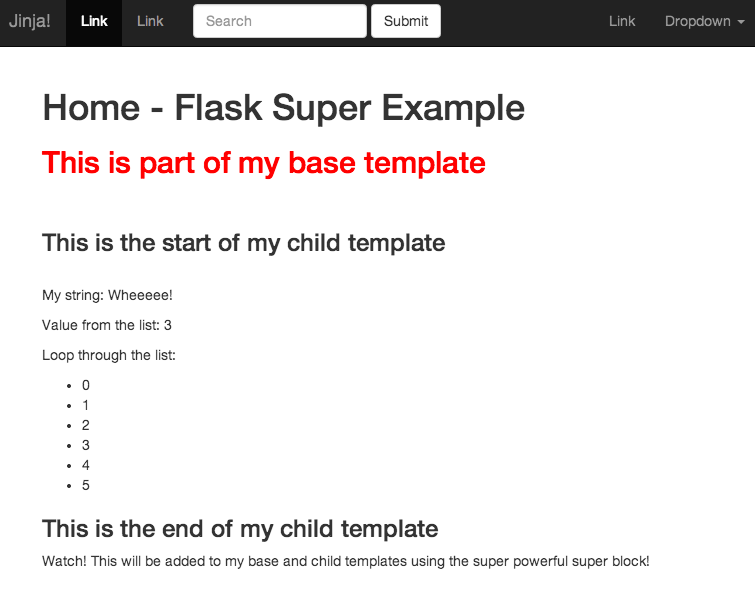
Super Blocks
If you need to render a block from the base template, employ a super block:
Add a footer to the base of operations template:
< div class = "footer" > {% cake footer %} Lookout! This volition be added to my base of operations and kid templates using the super powerful super block! < br > < br > {% endblock %} </ div > Here's the updated code:
<!DOCTYPE html> < head > < title >Flask Template Example</ championship > < meta name = "viewport" content = "width=device-width, initial-scale=one.0" > < link href = "http://netdna.bootstrapcdn.com/bootstrap/three.0.0/css/bootstrap.min.css" rel = "stylesheet" media = "screen" > < style type = "text/css" > . container { max-width : 500 px ; padding-top : 100 px ; } h2 { color : red ;} </ fashion > </ caput > < trunk > < div class = "container" > < h2 >This is part of my base of operations template</ h2 > < br > {% block content %}{% endblock %} < br > < h2 >This is function of my base template</ h2 > < br > < div form = "footer" > {% block footer %} Lookout! This will exist added to my base and child templates using the super powerful super block! < br > < br > < br > {% endblock %} </ div > </ div > < script src = "http://code.jquery.com/jquery-1.10.2.min.js" ></ script > < script src = "http://netdna.bootstrapcdn.com/bootstrap/3.0.0/js/bootstrap.min.js" ></ script > </ body > </ html > Run the app. You should run into that the footer is merely role of the base:
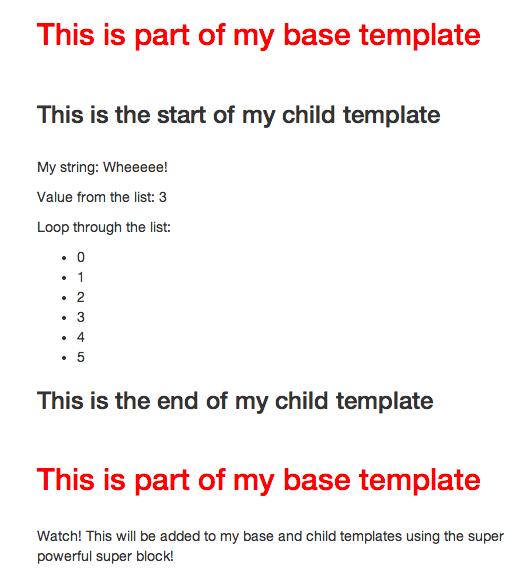
At present, add the super block to template.html:
{% extends "layout.html" %} {% block content %} < h3 > This is the outset of my child template</ h3 > < br > < p >My string: {{my_string}}</ p > < p >Value from the list: {{my_list[three]}}</ p > < p >Loop through the list:</ p > < ul > {% for n in my_list %} < li >{{n}}</ li > {% endfor %} </ ul > < h3 > This is the end of my child template</ h3 > {% block footer %} {{super()}} {% endblock %} {% endblock %} Check information technology out in your browser:
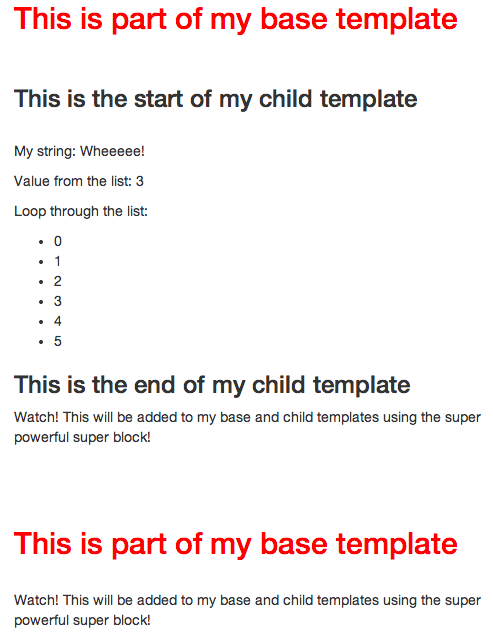
The super cake is used for common code that both the parent and child templates share, such every bit the <championship>, where both templates share part of the title. Then, yous would just need to pass in the other part. It could besides be used for a heading.
Here's an instance:
Parent
{% block heading %} < h1 >{% block page %}{% endblock %} - Flask Super Case</ h1 > {% endblock %} Kid
{% block page %}Home{% endblock %} {% cake heading %} {{ super() }} {% endblock %} Let's see that in action:
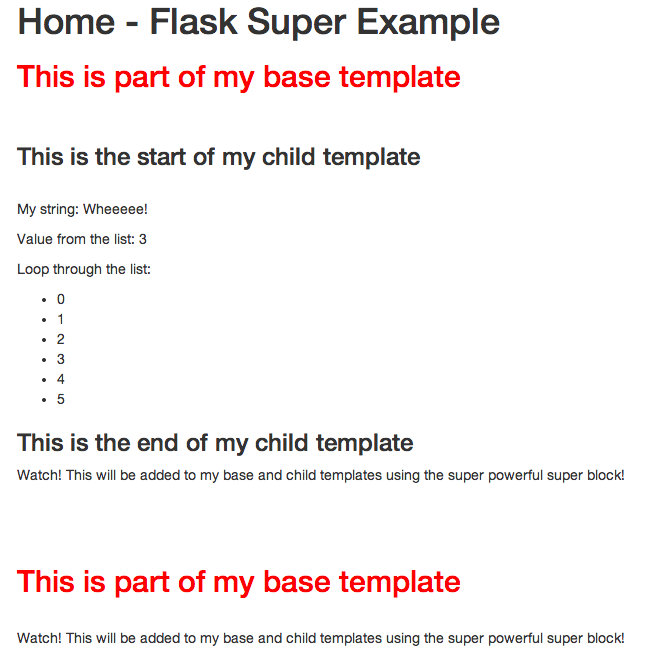
See what happens when y'all remove {% block folio %}Domicile{% endblock %} from the child template.
Instead of hard coding the proper name of the template, let'due south brand it dynamic.
Update the ii code snippets in template.html:
{% cake championship %}{{title}}{% endblock %} {% block page %}{{title}}{% endblock %} Now, we demand to laissez passer in a championship variable to our template from our controller, run.py:
@app . route ( "/" ) def template_test (): return render_template ( 'template.html' , my_string = "Wheeeee!" , my_list = [ 0 , 1 , two , 3 , 4 , 5 ], title = "Habitation" ) Examination this out.
Macros
In Jinja, we can employ macros to abstruse usually used code snippets that are used over and over to not repeat ourselves. For instance, information technology'southward common to highlight the link of the current folio on the navigation bar (active link). Otherwise, we'd have to use if/elif/else statements to make up one's mind the active link. Using macros, we can abstract out such code into a carve up file.
Add a macros.html file to the templates directory:
{% macro nav_link(endpoint, name) %} {% if request.endpoint.endswith(endpoint) %} < li class = "active" >< a href = "{{ url_for(endpoint) }}" >{{name}}</ a ></ li > {% else %} < li >< a href = "{{ url_for(endpoint) }}" >{{name}}</ a ></ li > {% endif %} {% endmacro %} Here, we're using Flask's request object, which is part of Jinja past default, to cheque the requested endpoint, and then assigning the active class to that endpoint.
Update the unordered listing with the nav navbar-nav form in the base template:
< ul class = "nav navbar-nav" > {{ nav_link('dwelling', 'Home') }} {{ nav_link('about', 'About') }} {{ nav_link('contact', 'Contact Us') }} </ ul > Likewise, make sure to add together the import at the top of the template: {% from "macros.html" import nav_link with context %}.
Notice how we're calling the nav-link macro and passing it two arguments: the endpoint (which comes from our controller) and the text we desire displayed.
Finally, let's add three new endpoints to the controller:
@app . road ( "/home" ) def home (): return render_template ( 'template.html' , my_string = "Wheeeee!" , my_list = [ 0 , 1 , 2 , 3 , iv , five ], title = "Habitation" ) @app . route ( "/about" ) def virtually (): return render_template ( 'template.html' , my_string = "Wheeeee!" , my_list = [ 0 , 1 , 2 , 3 , four , 5 ], title = "Almost" ) @app . route ( "/contact" ) def contact (): render render_template ( 'template.html' , my_string = "Wheeeee!" , my_list = [ 0 , i , two , three , 4 , 5 ], championship = "Contact Us" ) Refresh the folio. Exam out the links at the meridian. Does the current page get highlighted? It should.

Custom Filters
Jinja uses filters to modify variables, mostly for formatting purposes.
Here's an example:
This volition round the num variable. And so, if we pass the argument num=46.99 into the template, then 47.0 will be outputted.
As you can tell, you specify the variable and and then a pipe (|), followed by the filter. Check out this link for the list of filters already included within Jinja. In some cases, you can specify optional arguments in parentheses.
Hither's an example:
This will join a list by the comma delimiter.
Test this out. Add the following line to template.html
< p >Same list with a filter: {{ my_list|join(', ') }}</ p > At present, besides the built-in filters, we can create our own.
Let's add together i of our own. 1 mutual example is a custom datetime filter.
Add the following code to our controller later on we create the app, app = Flask(__name__):
@app . template_filter () def datetimefilter ( value , format = '%Y/%m/ %d %H:%M' ): """Convert a datetime to a different format.""" return value . strftime ( format ) app . jinja_env . filters [ 'datetimefilter' ] = datetimefilter Using the @app.template_filter() decorator, we are registering the datetimefilter() function as a filter.
Next, we are adding the filter to the Jinja environment, making it accessible. At present it'southward gear up for use.
Add the following code to our child template:
< h4 >Electric current engagement/time: {{ current_time | datetimefilter }}</ h4 > Finally, merely laissez passer in the datetime to our template:
current_time = datetime . datetime . now () Exam it.
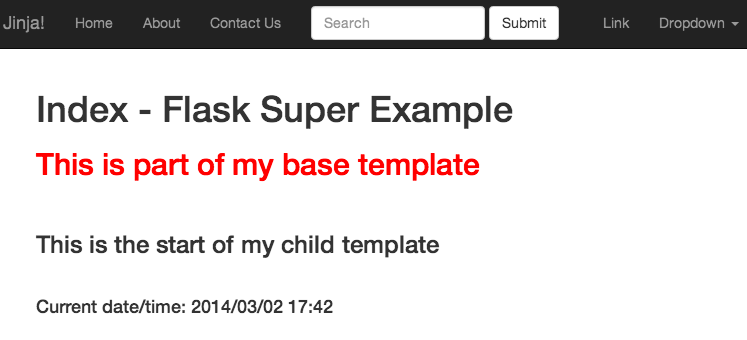
Conclusion
That'south it. Grab the sample lawmaking here. Did I miss anything? Leave a comment beneath.
Source: https://realpython.com/primer-on-jinja-templating/
0 Response to "How to Read a Input From Search Bar in Jinja"
إرسال تعليق